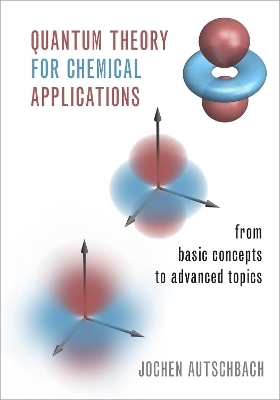
Quantum Theory for Chemical Applications
Oxford University Press Inc (Verlag)
978-0-19-092080-7 (ISBN)
Quantum theory and computational chemistry have become integral to the fields of chemistry, chemical engineering, and materials chemistry. Concepts of chemical bonding, band structure, material properties, and interactions between light and matter at the molecular scale tend to be expressed in the framework of orbital theory, even when numerical calculations go beyond simple orbital models. Yet, the connections between these theoretical models and experimental observations are often unclear. It is important--now more than ever--that students master quantum theory if they are going to apply chemical concepts. In this book, Jochen Autschbach connects the abstract with the concrete in an elegant way, creating a guiding text for scholars and students alike.
Quantum Theory for Chemical Applications covers the quantum theory of atoms, molecules, and extended periodic systems. Autschbach goes beyond standard textbooks by connecting the molecular and band structure perspectives, covering response theory, and more. The book is broken into four parts: Basic Theoretical Concepts; Atomic, Molecular, and Crystal Orbitals; Further Basic Concepts of Quantum Theory; and Advanced Topics, such as relativistic quantum chemistry and molecule-light interactions. The foresight Autschbach provides is immense, and he sets up a solid theoretical background for nearly every quantum chemistry method used in contemporary research.
Because quantum theory tells us what the electrons do in atoms, molecules, and extended systems, the pages in this book are full of answers to questions both long-held and never-before considered.
Jochen Autschbach is a UB Distinguished Professor and Larkin Professor at University at Buffalo, The State University of New York. Autschbach has authored or co-authored over 300 scientific journal articles and academic book chapters.
Preface
Notation Used in This Book
Motivation: Why it is Important to Know What Quantum Theory is About
Part I: Basic Theoretical Concepts
Chapter 1: Vectors and Functions and Operators
Chapter 2: Classical Mechanics According to Newton, Langrange, and Hamilton
Chapter 3: The Quantum Recipe
Chapter 4: Atomic Units
Chapter 5: A First Example: The "Particle in a Box" and Quantized Translational Motion
Part II: Atomic, Molecular, and Crystal Orbitals
Chapter 6: Hydrogen-Like Wave Functions: A First Sketch
Chapter 7: Many Electron Systems and the Pauli Principle
Chapter 8: Self-Consistent Field (SCF) Orbital Methods
Chapter 9: From Atomic Orbitals to Molecular Orbitals and Chemical Bonds
Chapter 10: Orbital-Based Descriptions of Electron Configurations, Ionization, Excitation, and Bonding
Chapter 11: Recap: Molecular Orbitals and Common Misconceptions
Chapter 12: Approximate Molecular Orbital Theory: The Hückel/Tight-Binding Model
Chapter 13: Band Structure Theory for Extended Systems
Part III: Basic Concepts of Quantum Theory Continued
Chapter 14: Quantized Vibrational Motion
Chapter 15: Quantized Rotational Motion in a Plane
Chapter 16: Angular Momentum and Rational Motion in Three Dimensions
Chapter 17: Hydrogen-Like Atoms
Chapter 18: Particle in a Cylinder, in a Sphere, and on a Helix
Chapter 19: Electron Spin and General Angular Momenta
Part IV: Advanced Topics
Chapter 20: Post-Hartree-Fock Methods and Electron Correlation: A Very Brief Overview
Chapter 21: The One-Electron Quantum Hamiltonian in the Presence of Electromagnetic Fields
Chapter 22: Static Perturbation Theory and Derivative Properties
Chapter 23: Dynamic Fields and Response Properties
Chapter 24: From Schrödinger to Einstein: Relativistic Effects
Part V: Appendix
A. Complex Numbers
B. Linear Algebra Essentials
C. Some Useful Relationships Involving Functions, Vector Fields, and the Operator V
D. One- and Two-Center Integrals Over 1s Slater-Type Functions
E: Point Group Symmetry
F. Ensembles of Electrons and Quantum Statistics
G. Gaussian and CGS Units
H. Solutions for Selected Exercises
Further Reading
Index
| Erscheinungsdatum | 15.01.2021 |
|---|---|
| Verlagsort | New York |
| Sprache | englisch |
| Maße | 175 x 257 mm |
| Gewicht | 1474 g |
| Themenwelt | Naturwissenschaften ► Chemie ► Analytische Chemie |
| Naturwissenschaften ► Chemie ► Physikalische Chemie | |
| ISBN-10 | 0-19-092080-7 / 0190920807 |
| ISBN-13 | 978-0-19-092080-7 / 9780190920807 |
| Zustand | Neuware |
| Informationen gemäß Produktsicherheitsverordnung (GPSR) | |
| Haben Sie eine Frage zum Produkt? |
aus dem Bereich


